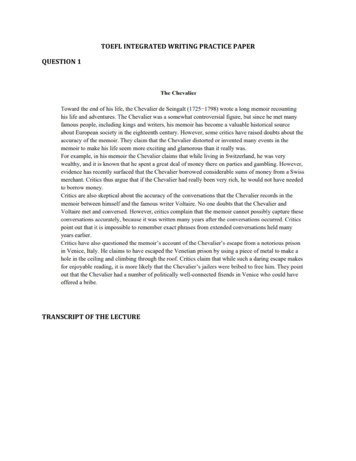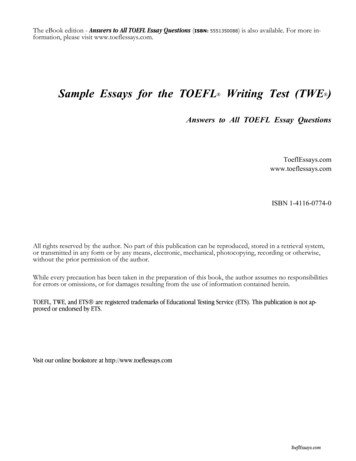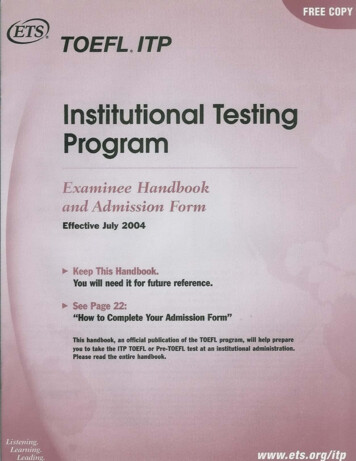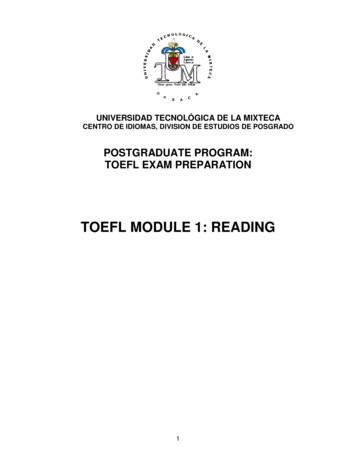
Transcription
TOEFL INTEGRATED WRITING PRACTICE PAPERQUESTION 1TRANSCRIPT OF THE LECTURE
Question: 2Life on MarsReading Passage:For years, scientists have been trying to discover whether life exists on Mars. Most haveconcluded that the Martian environment today is too harsh to support living organisms.However, three recent discoveries lend support to the idea that there may very well be lifeon Mars after all. First, large amounts of methane have been detected in the Martianatmosphere. This suggests the presence of living methanogens, tiny organisms that releasemethane into the atmosphere as a by-product of their life processes. Methanogens get theirenergy from hydrogen in rocks and do not need oxygen or sunlight to live, so they can
survive in harsh environments like Mars. Since methane can remain in Mars’ atmosphereonly for a few centuries after it’s created, these methanogens must be present andproducing methane today.Second, the existence of life on Mars is also strongly supported by a meteorite discovered inAntarctica in 1996. The particular chemical composition of this meteorite indicates that itis a rock from the surface of Mars. The meteorite also contains chemically pure and flawlesscrystals of the compound magnetite. Such magnetite crystals are produced in nature onlyby bacteria. Third, observations of hydrogen on Mars made in 2001 by NASA’s MarsOdyssey spacecraft suggest the presence of liquid water there that could supportorganisms. The spacecraft detected the hydrogen in the top layer of Martian soil. Thishydrogen is just what one would expect if there were liquid water under the surface. Asubterranean reservoir of liquid water is an extremely suitable environment formicroscopic life.Listening:[Narrator] Now listen to part of a lecture on the topic you just read about.[Professor] Mars is a very unfriendly place for life. The evidence that has been put forwardas supporting there being life on Mars is actually very ambiguous. The facts as we knowthem can easily be accounted for without supposing life on Mars. First, methanogens arenot necessarily the source of the methane. Methane can be produced by non biologicalprocesses like volcanic eruptions. The same experiments that detected the atmosphericmethane also indicated recent volcano activity. Moreover, unlike methanogens, volcanoeshave actually been found on Mars. So since no methanogens have been found yet, it’s morelikely that volcanoes are the source of Mars’s methane. Second, while the magnetite crystalsfound in the meteorite from Mars were probably made by bacteria, there is no indicationthat the bacteria themselves originated on Mars. The meteorite arrived on Earth about13,000 years ago, which means it has had thousands of years to become exposed tobacteria on Earth. So it could have been bacteria on Earth that formed the crystals we nowobserve. Indeed, recent research performed on the meteorite found that, in fact, it hasbecome contaminated by Earth bacteria. Since the sample has been contaminated, themagnetite crystals on the meteorite cannot be used as evidence for life on Mars. Third,what about the supposed existence of liquid water near enough to the surface of Mars tosupport life? The recent investigations of Mars detected hydrogen; they didn’t detect liquidwater per se. It’s actually much more likely that if there’s any water close to the Martiansurface, it’s frozen; in other words, it’s ice, not liquid water. And that’s not a greatenvironment for life.Prompt: Summarize the points made in the lecture, being sure to explain how theycast doubt on the specific points made in the reading passage.QUESTION 3READING PASSAGE
There are different types of universities. Some universities focus almost completely onresearch. These universities reward professors for doing research. They hire professorsthat are dedicated to discovering new things and publishing their findings. Otheruniversities focus more on teaching. These universities hire professors that are able toexplain concepts to their students clearly. Some universities have tried to blend bothapproaches and focus on both research and quality teaching, which is problematic.First, both doing research and teaching take time, and having a dual focus will distractprofessors from being adequately prepared for their classes. Doing research can often be amessy, complex process, and they may end up spending so much time doing research thatthey don’t have time to prepare their lectures or exams. When professors are notadequately prepared for classes, students may struggle more to understand the conceptsand do well in class. If professors are expected to both teach and research, they will nothave time for both.Also, there is no real benefit researchers bring to the classroom if they lack teachingskills. Many researchers who teach as professors have had limited teacher training. Theyhave extensive knowledge of their field, but do not know how to manage a classroom, writea reliable assessment, or scaffold student learning. Students are very frustrated byprofessors who lack these teaching skills. Teaching skills are necessary in order to helpstudents learn; thus, experts without formal teacher training don’t have a clear advantage.Finally, by choosing one focus, professors can become more skilled in what they chooseto do. If they choose to be a researcher, they can make a name for themselves in researchbecause they can devote all of their time to research. If they choose to be a teacher, they cangain the teaching skills they need to be an excellent teacher, rather than trying to maketime to research as well.TRANSCRIPTProfessor: Well, as you know from the reading, there are some reasonable concerns aboutuniversities that blend teaching and research. You will find some people, especially in thisarea, are passionate about this topic.There are some points I want to make today during our class that weren’t included in yourreading. I think that it’s important to understand both sides of this issue.Something that people don’t always think about is how researching can make planninglessons easier. If you have a teacher who is a teacher and a researcher, they are very up-todate in their field, so they don’t have to spend the same amount of time preparing forclasses. Their research is their preparation.Rather than waiting for other researchers to investigate questions and publish theirfindings, researching professors are on the cutting edge of their field. They attendconferences and find out what other researchers are doing as they are doing it. The time
they spend at these conferences is time well spent to prepare them for their teachingassignments.While it is true that researching professors may not have the practical teaching skills thatother teachers have, they are passionate about their subject because what they research iswhat they chose to pursue for their career.One of my colleagues here in the department is famous for staying late to work on apresentation for class the next day because he is so excited to share his latest discoverywith his students. His students love his lectures because they can tell how much the topicinterests him, and they enjoy seeing the results of his research.A final point I’ll mention on this topic is that by only focusing on one thing, professors oftenget stuck. Teachers who don’t do research tend to use the same books and go over the samematerial year after year. Teachers who research are able to continue growing because oftheir involvement in the field.Researchers can also get stuck in a rut without the fresh perspective that teaching canbring.Question:Summarize the points made in the lecture, being sure to explain how they challengespecific arguments made in the reading passage.There are lots of differents kinds of professors. Some teach and do research, but others justteach. The author likes professors to focus in teaching.The professor says that research makes lesson planning go better, but the article says thatteachers who do research don’t have time enough for both.The professor says that when professors research they have a very passion for the subjectthey teach. On the other hand, the author of the article isn’t agree.The author of the article said that teachers get more skill by focusing on one thing. theprofessor completely disagrees with this opinion.In conclusion, there are different types of professors and it is important to know what kindof professors you will have.QUESTION 4READING PASSAGEJane Austen (1775-1817) is one of the most famous of all English novelists, and today hernovels are more popular than ever, with several recently adapted as Hollywood movies.
But we do not have many records of what she looked like. For a long time, the onlyaccepted image of Austen was an amateur sketch of an adult Austen made by her sisterCassandra. However recently a professionally painted, full-length portrait of a teenage girlowned by a member of the Austen family has come up for sale. Although the professionalpainting is not titled Jane Austen, there are good reasons to believe she is the subject.First, in 1882, several decades after Austen's death, Austen's family gave permission to usethe portrait as an illustration in an edition of her letters. Austen's family clearly recognizedit as a portrait of the author. So, for over a century now, the Austen family itself hasendorsed the claim that the girl in the portrait is Jane Austen.Second, the face in the portrait clearly resembles the one in Cassandra's sketch, which weknow depicts Austen. Though somewhat amateurish, the sketch communicates definitedetails about Austen's face. Even though the Cassandra sketch is of an adult Jane Austen,the features are still similar to those of the teenage girl in the painting. The eyebrows, nose,mouth, and overall shape of the face are very much like those in the full-length portrait.Third, although the painting is unsigned and undated, there is evidence that it was paintedwhen Austen was a teenager. The style links it to Ozias Humphrey, a society portraitpainter who was the kind of professional the wealthy Austen family would hire. Humphreywas active in the late 1780s and early 1790s, exactly the period when Jane Austen was theage of the girl in the painting.LISTENING PASSAGEProfessor:The evidence linking this portrait to Jane Austen is not at all convincing. Sure, the paintinghas long been somewhat loosely connected to Austen's extended family and theirdescendents, but this hardly proves it's a portrait of Jane Austen as a teenager. Thereading's arguments that the portrait is of Austen are questionable at best.First, when the portrait was authorized for use in the 1882 publication of her letters, JaneAusten had been dead for almost 70 years. So the family members who asserted that thepainting was Jane had never actually seen her themselves. They couldn't have known forcertain if the portrait was of Austen or not.Second, the portrait could very well be that of a relative of Austen's, a fact that wouldexplain the resemblance between its subject and that of Cassandra's sketch. The extendedAusten family was very large and many of Jane Austen's female cousins were teenagers inthe relevant period or had children who were teenagers. And some of these teenage girls
could have resembled Jane Austen. In fact, many experts believe that the true subject of theportrait was one of those relatives, Marianne Kempian, who was a distant niece of Austen's.Third, the painting has been attributed to Humphrey only because of the style. But otherevidence points to a later date. A stamp on the back of the picture indicates that the blankcanvas, you know the actual piece of cloth on which the picture was painted, was sold by aman named William Legg. Record showed that William Legg did not sell canvases inLondon when Jane Austen was a teenager. He only started selling canvases when she was27 years old. So it looks like the canvas was used for the painting at a time when Austenwas clearly older than the girl in the portrait.
TOEFL INTEGRATED WRITING PRACTICE PAPER QUESTION 1 TRANSCRIPT OF THE LECTURE . Question: 2 Life on Mars Reading Passage: For years, scientists have been trying to discover whether life exists on Mars. Most have concluded that the Martian en










